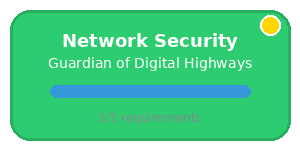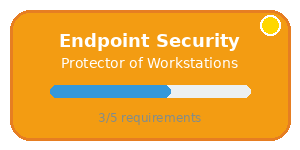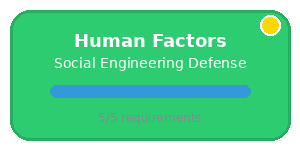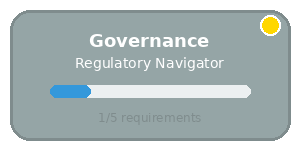Training and Progression
The Path to Cybersecurity Mastery
Malware & Monsters isn’t just about individual sessions - it’s about building genuine cybersecurity expertise through structured progression. Like any skill-based pursuit, your abilities grow through practice, collaboration, and increasingly challenging scenarios.
The Training and Progression system recognizes your developing expertise, provides clear advancement paths, and creates opportunities to take on greater cybersecurity challenges while building a community of collaborative defenders.
Experience and Skill Development
How You Gain Experience
Session-Based Learning
Every Malware & Monsters session provides multiple opportunities to develop cybersecurity skills:
Discovery Achievements:
- First Contact: Successfully identifying a new Malmon type (+2 XP)
- Pattern Recognition: Connecting symptoms to specific attack techniques (+3 XP)
- Evidence Analysis: Drawing accurate conclusions from digital artifacts (+3 XP)
- Collaborative Insight: Building on teammates’ discoveries (+2 XP)
Investigation Mastery:
- Impact Assessment: Accurately determining attack scope and damage (+4 XP)
- Attribution Analysis: Identifying attack techniques and potential threat actors (+5 XP)
- Vulnerability Identification: Understanding how the attack succeeded (+4 XP)
- Timeline Construction: Building accurate attack progression narratives (+3 XP)
Response Excellence:
- Strategic Containment: Selecting optimal controls for specific Malmon types (+5 XP)
- Team Coordination: Effectively coordinating multi-role response efforts (+4 XP)
- Crisis Communication: Managing stakeholder expectations during incidents (+3 XP)
- Adaptive Response: Adjusting strategy when initial approaches prove ineffective (+6 XP)
Role-Specific Expertise Development
Each role has specialized advancement tracks reflecting real cybersecurity career paths:
🔍 Detective Advancement:
- Forensic Analysis: Digital evidence examination and timeline construction
- Threat Research: Understanding malware families and attack techniques
- Pattern Recognition: Identifying anomalies and attack indicators
- Intelligence Development: Creating actionable threat intelligence
🛡️ Protector Advancement:
- System Hardening: Implementing effective security controls and configurations
- Incident Response: Technical containment and recovery procedures
- Risk Assessment: Evaluating and prioritizing security vulnerabilities
- Security Architecture: Designing defensive systems and processes
📡 Tracker Advancement:
- Network Analysis: Understanding traffic patterns and communication flows
- Behavioral Monitoring: Detecting anomalous activities and attack progression
- Data Flow Security: Protecting information in transit and at rest
- Infrastructure Defense: Securing network architecture and services
👥 Communicator Advancement:
- Stakeholder Management: Coordinating with executives, users, and external parties
- Crisis Communication: Managing information flow during security incidents
- Business Alignment: Translating technical security issues into business language
- Compliance Coordination: Managing regulatory and legal aspects of incidents
⚡ Crisis Manager Advancement:
- Incident Coordination: Orchestrating complex, multi-team response efforts
- Resource Management: Allocating personnel, tools, and time effectively
- Strategic Planning: Balancing immediate response with long-term recovery
- Organizational Leadership: Building and maintaining effective security programs
🎯 Threat Hunter Advancement:
- Proactive Investigation: Finding threats before they trigger alerts
- Adversary Analysis: Understanding attacker tactics, techniques, and procedures
- Hypothesis Testing: Developing and validating theories about threat activity
- Intelligence Integration: Using external intelligence to guide hunting activities
Skill Rating System
Individual Competencies
Your growing expertise is tracked across multiple dimensions:
Technical Skills (1-10 scale):
- Malware Analysis: Understanding threat capabilities and behaviors
- Network Security: Protecting and monitoring network infrastructure
- Digital Forensics: Investigating and analyzing security incidents
- Risk Assessment: Evaluating and prioritizing security concerns
- Security Architecture: Designing effective defensive systems
Collaboration Skills (1-10 scale):
- Team Coordination: Working effectively with diverse incident response teams
- Knowledge Sharing: Teaching and learning from cybersecurity colleagues
- Communication: Explaining technical concepts across different audiences
- Leadership: Guiding teams through complex security challenges
- Adaptability: Adjusting approach based on new information and circumstances
Organizational Skills (1-10 scale):
- Business Understanding: Connecting security activities to organizational objectives
- Compliance Knowledge: Understanding regulatory and legal requirements
- Vendor Management: Working with external security providers and tools
- Training Development: Building cybersecurity capabilities in others
- Strategic Thinking: Planning long-term security improvements
Skill Development Through Practice
Novice Level (Skills 1-3):
- Focus on learning basic concepts and terminology
- Practice fundamental techniques with guidance
- Develop confidence in core role responsibilities
- Build relationships with more experienced team members
Competent Level (Skills 4-6):
- Apply knowledge independently in routine situations
- Contribute meaningfully to team efforts
- Begin specializing in areas of particular interest
- Mentor newcomers to cybersecurity
Expert Level (Skills 7-9):
- Handle complex, non-routine cybersecurity challenges
- Lead response efforts for sophisticated threats
- Develop new techniques and approaches
- Train and develop other cybersecurity professionals
Master Level (Skill 10):
- Innovate solutions for novel cybersecurity problems
- Shape organizational and community cybersecurity practices
- Publish research and contribute to the field
- Build and lead high-performing cybersecurity teams
Security Domain Mastery
The Badge System
Recognition of your growing expertise comes through Security Domain Badges - achievements that demonstrate mastery of specific cybersecurity disciplines.
Core Security Domains
🌐 Network Security Badge “Guardian of Digital Highways”

Requirements:
- Successfully contain 5 Worm-type Malmons using network isolation
- Demonstrate proficiency with traffic analysis and monitoring
- Coordinate effective network-based incident response
- Contribute to network security architecture improvements
Skills Demonstrated:
- Network traffic analysis and anomaly detection
- Firewall configuration and network segmentation
- Intrusion detection and prevention systems
- Network forensics and incident investigation
Career Connections: Network Security Engineer, SOC Analyst, Network Architect
💻 Endpoint Security Badge “Protector of Digital Workstations”

Requirements:
- Successfully contain 5 Trojan or Rootkit-type Malmons
- Master behavioral analysis and system monitoring techniques
- Lead system recovery and hardening efforts
- Develop endpoint protection strategies
Skills Demonstrated:
- Host-based intrusion detection and response
- Malware analysis and reverse engineering
- System forensics and timeline analysis
- Endpoint protection platform management
Career Connections: Incident Response Specialist, Malware Analyst, Endpoint Security Engineer
🗄️ Data Protection Badge “Guardian of Digital Assets”

Requirements:
- Successfully defend against 5 Ransomware or Infostealer-type Malmons
- Implement effective backup and recovery strategies
- Demonstrate data loss prevention techniques
- Lead data breach response efforts
Skills Demonstrated:
- Data classification and handling procedures
- Encryption implementation and key management
- Backup strategy development and testing
- Data breach investigation and notification
Career Connections: Data Protection Officer, Compliance Manager, Risk Analyst
👤 Human Factor Security Badge “Defender Against Social Engineering”

Requirements:
- Successfully counter 5 social engineering or phishing-based attacks
- Develop effective security awareness training programs
- Demonstrate crisis communication skills
- Lead user education and awareness efforts
Skills Demonstrated:
- Social engineering attack recognition and prevention
- Security awareness training development and delivery
- Incident communication and stakeholder management
- Behavioral security risk assessment
Career Connections: Security Awareness Manager, Training Coordinator, Risk Communication Specialist
🏭 Critical Infrastructure Security Badge “Protector of Essential Systems”

Requirements:
- Successfully defend against 3 industrial control system threats
- Understand operational technology (OT) security principles
- Coordinate IT/OT security integration efforts
- Develop business continuity and disaster recovery plans
Skills Demonstrated:
- Industrial control system (ICS/SCADA) security
- Operational technology risk assessment
- Business continuity planning and implementation
- Critical infrastructure protection strategies
Career Connections: Critical Infrastructure Protection Specialist, OT Security Engineer, Business Continuity Manager
🏛️ Governance and Compliance Badge “Navigator of Regulatory Requirements”

Requirements:
- Successfully manage compliance aspects of 5 security incidents
- Demonstrate understanding of relevant regulatory frameworks
- Lead compliance reporting and documentation efforts
- Develop risk management and governance programs
Skills Demonstrated:
- Regulatory compliance management (GDPR, HIPAA, SOX, etc.)
- Risk assessment and management frameworks
- Incident reporting and documentation
- Security governance and policy development
Career Connections: Compliance Officer, Risk Manager, Governance Specialist, CISO
Advanced Specialization Tracks
Elite Challenge Levels
🔥 APT Specialist “Hunter of Advanced Persistent Threats”
Requirements:
- Successfully counter 3 nation-state level Malmons (⭐⭐⭐)
- Demonstrate advanced threat hunting capabilities
- Lead complex, multi-month incident investigations
- Develop threat intelligence and attribution analysis
Skills Demonstrated:
- Advanced persistent threat detection and response
- Threat actor profiling and attribution analysis
- Long-term incident investigation and case management
- Threat intelligence development and sharing
🌍 Global Incident Commander “Leader of International Response Efforts”
Requirements:
- Coordinate incident response across multiple organizations
- Manage complex, multi-stakeholder security incidents
- Demonstrate cross-cultural communication and coordination
- Lead international cybersecurity cooperation efforts
Skills Demonstrated:
- Large-scale incident command and coordination
- International cybersecurity cooperation and information sharing
- Cross-organizational relationship building and management
- Crisis leadership and decision-making under pressure
🧪 Security Researcher “Discoverer of New Threats and Defenses”
Requirements:
- Discover and document a new Malmon variant or technique
- Publish original cybersecurity research
- Contribute new detection or defense capabilities to the community
- Mentor other researchers and practitioners
Skills Demonstrated:
- Original cybersecurity research methodology
- Malware analysis and reverse engineering
- Vulnerability research and responsible disclosure
- Academic and industry research publication
Community Recognition and Leadership
Trainer Certification Pathway
Level 1: Session Assistant
Requirements:
- Complete 10 Malware & Monsters sessions as participant
- Demonstrate proficiency across all 6 roles
- Show consistent collaborative learning behavior
- Receive recommendation from experienced Incident Master
Responsibilities:
- Assist Incident Masters with session setup and logistics
- Help new participants understand game mechanics
- Provide technical expertise when called upon
- Support community building and engagement activities
Level 2: Incident Master
Requirements:
- Complete Level 1 certification requirements
- Successfully facilitate 5 sessions under mentor supervision
- Demonstrate effective question-asking and facilitation skills
- Show ability to adapt sessions for different audience expertise levels
Responsibilities:
- Independently facilitate Malware & Monsters sessions
- Adapt scenarios for different organizational contexts
- Mentor new facilitators and session assistants
- Contribute to scenario development and improvement
Level 3: Master Trainer
Requirements:
- Complete Level 2 certification requirements
- Train 10 new Incident Masters
- Develop original scenarios or Malmons for community use
- Demonstrate leadership in community building and outreach
Responsibilities:
- Train and certify new Incident Masters
- Develop advanced scenarios and training materials
- Lead community initiatives and improvements
- Represent the community at conferences and professional events
Community Contribution Recognition
Malmon Discoverer
“First to encounter and document new threats”
- Recognition for discovering and documenting new Malmon variants
- Naming rights for contributed Malmons
- Special recognition in community documentation
- Priority access to advanced training and certification opportunities
Scenario Architect
“Creator of compelling learning experiences”
- Recognition for developing high-quality training scenarios
- Credit for contributed scenarios used by other facilitators
- Invitation to participate in curriculum development efforts
- Opportunity to present at community conferences and events
Community Champion
“Builder of collaborative learning networks”
- Recognition for outstanding community building and engagement
- Leadership opportunities in community governance and direction
- Invitation to participate in strategic planning and development
- Special recognition at community events and publications
Progression Tracking and Goal Setting
Personal Development Planning
Skill Assessment and Goal Setting
Regular self-assessment helps track progress and identify development priorities:
Quarterly Skill Review Questions:
- Which cybersecurity domains am I most interested in pursuing?
- What specific skills do I want to develop in the next quarter?
- Which Security Domain Badges align with my career goals?
- How can I contribute more effectively to team efforts?
- What advanced challenges am I ready to take on?
Individual Development Plans
Create structured plans for advancing your cybersecurity expertise:
Goal Setting Framework:
- Technical Skill Goals: Specific competencies to develop or improve
- Collaboration Goals: Ways to enhance team effectiveness and leadership
- Community Goals: Contributions to the broader cybersecurity community
- Career Goals: Professional development and advancement objectives
- Learning Goals: New areas of cybersecurity to explore and understand
Team Development and Advancement
Collective Capability Building
Teams that regularly work together can pursue collective advancement:
Team Achievement Tracks:
- Rapid Response Team: Consistently achieve containment in minimal time
- Complex Threat Specialists: Successfully handle the most sophisticated Malmons
- Training Excellence: Develop and deliver outstanding cybersecurity education
- Innovation Leaders: Create new techniques and approaches for the community
Organizational Integration
Connect Malware & Monsters progression to real organizational development:
Professional Development Integration:
- Align badge requirements with job role expectations
- Use skill assessments for performance review and development planning
- Connect community contributions to professional recognition programs
- Integrate training progression with career advancement opportunities
Remember that cybersecurity expertise develops over time through consistent practice, continuous learning, and meaningful collaboration. Focus on contributing to your team’s success, learning from every experience, and building relationships with others who share your commitment to defending against digital threats.
The progression system recognizes that cybersecurity mastery comes from combining technical knowledge, practical experience, and collaborative skills. Every session is an opportunity to grow, every challenge a chance to learn, and every success a step toward building a more secure digital world.
In the next chapter, we’ll explore the specific Game Mechanics that make all these learning experiences possible - from dice rolls and decision points to the collaborative storytelling that brings cybersecurity scenarios to life.